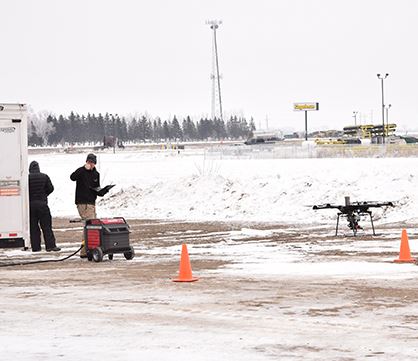The University of North Dakota (UND), along with research partners from Harris Corporation and the Northern Plains Unmanned Aircraft Systems Test Site (NPUASTS), report it has achieved a major industry milestone on 21 December with the first-ever test flights over a specially developed UAS network of technologies that will open the door to beyond visual line of sight (BVLOS) drone operations in national airspace.
The North Dakota-based Harris UAS Network, which combines detect-and-avoid capabilities developed at UND and UAS technology solutions and services from Harris, is a system of integrated ground infrastructure that enables commercial UAS to fly much farther and safer beyond the visual line of sight (BVLOS) in national airspace.
The new North Dakota network keeps watch over a 55-mile-long corridor between Grand Forks and Fargo, representing, what the researchers say is the drone industry’s first-ever implementation of wide-area, multi-user UAS BVLOS airspace.
The successful flights, which took place about a mile west of Hillsboro in the Red River Valley of Eastern North Dakota, tested the Harris UAS Network’s ability to provide UAS pilots with airspace awareness to stay well clear of manned aircraft and other objects. The network is enhanced by locally deployed sensors for both cooperative and non-cooperative (radar) surveillance as well as integration of the Federal Aviation Administration’s (FAA) NextGen UAS surveillance data feed.
Mark Askelson, interim executive director of UND’s Research Institute for Autonomous Systems (RIAS) and an expert on the use of radar technology, said the successful test flights in North Dakota are a big step toward unleashing a multi-billion-dollar industry for unmanned capabilities.
“A lot of the technology was developed at the University of North Dakota, so this is a huge day and a very big deal for us as well as for our partners at Harris and the Northern Plains UAS Test Site,” Askelson said.
Chris Theisen, director of research and development for the NPUASTS, said the UAS network is part of a North Dakota Department of Commerce ResearchND project that grew out of prior UAS research collaborations between UND, the NPUASTS and Harris.
Theisen and his crew are executing the test flights and monitoring the effectiveness of the technologies that make up the network. “These tests signify the start of operations on the network, which is the first one anywhere that’s been deployed for multi-user commercial applications,” Theisen said. “It’s a significant milestone in the development of the commercial UAS industry — in our country as well as globally — and we’re proud that it took place right here in North Dakota.”
The Harris UAS Network in North Dakota got another shot of momentum recently when North Dakota Gov. Doug Burgum showed his support by recommending USD30 million to develop statewide infrastructure supporting UAS BLVOS operations.
“The idea is that what we’re doing here with Harris and the Northern Plains UAS Test Site will serve as a template to build out to other locations in the state and then across the country,” Askelson said.




